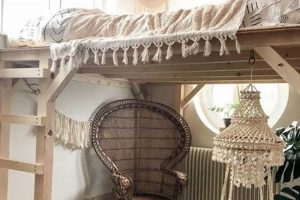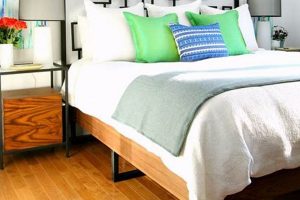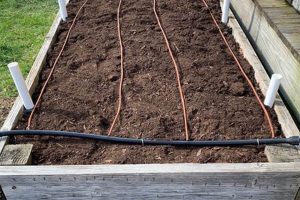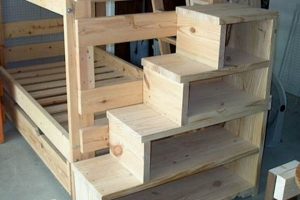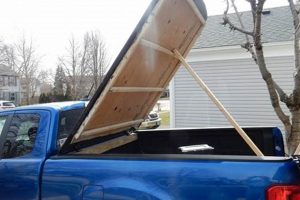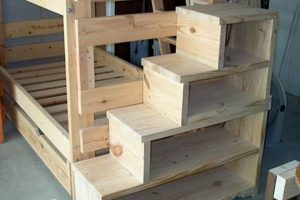A do-it-yourself sleeping enclosure, designed to be placed atop or around a bed, provides a personalized and often cost-effective alternative to commercially available products. These structures typically utilize readily accessible materials such as fabric, poles, or rope to create a confined space that can offer enhanced privacy, reduced light exposure, or protection from insects. A simple example involves draping fabric over an existing frame constructed from PVC pipes to form a cozy, enclosed sleeping area.
The significance of crafting a personal sleeping sanctuary lies in its adaptability to individual needs and preferences. Benefits can extend to improved sleep quality through light and noise reduction, creation of a comforting and secure environment, and a sense of personalized space within shared living areas. Historically, similar structures have been employed across various cultures and contexts for warmth, privacy, or protection against the elements, demonstrating a longstanding human desire for controlled sleeping environments.
This article will delve into diverse construction methods, material selection considerations, design possibilities, and safety guidelines relevant to the creation of a customized sleeping enclosure.
Crafting a Personalized Sleeping Enclosure
The following recommendations aim to ensure a successful and safe project, encompassing planning, construction, and usage of a customized sleeping enclosure.
Tip 1: Prioritize Structural Integrity: The framework must be stable and capable of supporting the chosen materials without risk of collapse. Evaluate weight distribution and secure all connections meticulously. For instance, if utilizing PVC pipes, employ appropriate connectors and ensure they are firmly cemented.
Tip 2: Select Fire-Retardant Materials: Choosing fabrics and components treated with fire retardant is crucial for safety. Verify that the materials comply with relevant fire safety standards. Avoid using highly flammable materials like untreated cotton or certain synthetic fabrics.
Tip 3: Ensure Adequate Ventilation: Proper airflow is essential to prevent stuffiness and maintain air quality within the enclosure. Incorporate ventilation openings or breathable fabrics to facilitate air circulation. Regular monitoring of temperature and humidity is advisable.
Tip 4: Implement Secure Fastening Mechanisms: Secure the enclosure to the bed frame or surrounding structure to prevent accidental displacement. Utilize robust straps, clips, or ties to ensure stability. Regularly inspect these mechanisms for wear and tear.
Tip 5: Optimize Light and Sound Control: Consider the degree of light and sound blockage desired. Darker, heavier fabrics will offer greater reduction, while lighter materials will provide more ambient light. Soundproofing measures can also be incorporated for enhanced noise reduction.
Tip 6: Incorporate Accessibility Features: Design the enclosure with easy access for entry and exit. Employ zippers, Velcro closures, or overlapping fabric panels for convenient access points. Ensure that these access points are easily operable from both inside and outside the enclosure.
Tip 7: Consider Storage Solutions: Integrate pockets or hanging organizers within the design to maximize space and keep essential items within reach. These features can enhance functionality and organization within the enclosed area.
Adhering to these guidelines contributes to a safe, functional, and personalized sleeping environment. Careful planning and execution are paramount to realizing the intended benefits of a customized sleeping enclosure.
The subsequent sections will explore various design options and material choices to further refine the creation of a tailored sleeping space.
1. Material Selection
Material selection exerts a primary influence on the performance and characteristics of a sleeping enclosure. The chosen materials directly affect factors such as light blockage, temperature regulation, breathability, durability, and overall safety. For example, a tightly woven, opaque fabric like blackout cloth effectively minimizes light penetration, facilitating a darker sleeping environment, whereas a lightweight, breathable fabric like cotton allows for better air circulation, reducing the risk of overheating. The structural integrity of the tent relies on the chosen materials for the frame, with PVC pipes or wooden dowels offering varying degrees of support and stability. The inherent flammability of certain materials also necessitates careful consideration to mitigate fire hazards. Selecting appropriate materials is, therefore, a fundamental prerequisite for constructing a functional and safe sleeping enclosure.
The practical application of material selection principles is evident in various design choices. Consider the use of mosquito netting as a component of a warm-climate sleeping enclosure. Its open weave structure prioritizes ventilation while providing a barrier against insects. Alternatively, in colder climates, heavier fabrics like fleece or canvas might be selected to retain heat. Furthermore, the choice of fasteners, such as zippers or Velcro, influences the ease of access and the overall aesthetic of the structure. Impermeable materials could also be beneficial, acting as protection against allergens present in the air
In conclusion, the strategic selection of materials forms the cornerstone of a well-designed sleeping enclosure. Understanding the properties of different materials and their impact on performance characteristics enables the creation of a customized sleeping environment tailored to specific needs and conditions. The challenges associated with material selection lie in balancing desired features with considerations of cost, availability, and ease of construction. Overcoming these challenges through informed decision-making ensures the creation of a sleeping enclosure that is both functional and safe.
2. Structural Stability
Structural stability is a paramount consideration in the design and construction of a do-it-yourself sleeping enclosure. The enclosure’s integrity is directly linked to its ability to withstand external forces, preventing collapse and ensuring the safety of the occupant. Insufficient structural integrity can lead to a sudden failure of the tent’s framework, posing a risk of injury. For instance, a poorly constructed frame using lightweight materials may buckle under the weight of the fabric or due to minimal external pressure. A lack of secure connections between structural components can result in instability and potential detachment. The selection of materials, the design of the framework, and the quality of the connections all contribute to the overall structural stability of the unit.
The practical significance of understanding structural stability is evident in the selection of appropriate framing materials. PVC pipes, while lightweight and affordable, may require reinforcement to support heavier fabrics or withstand significant stress. Wooden dowels, offering greater inherent strength, can be a viable alternative. The design of the frame itself also plays a critical role. A simple A-frame design may be inherently less stable than a dome-shaped structure, which distributes weight more evenly. Furthermore, secure attachment points to the bed frame are essential to prevent the enclosure from shifting or toppling over. Examples include using adjustable straps with buckles, clamps, or creating a fitted base that integrates with the beds existing structure. Fabric tension is another essential parameter related to structual stability. Tight fabric might add external strength to frame but loose one adds instability.
In conclusion, structural stability is an indispensable element of any DIY sleeping enclosure. A commitment to sound engineering principles, careful material selection, and robust construction techniques is crucial to ensuring the safety and longevity of the structure. Addressing the challenges associated with achieving adequate stability contributes to a secure and functional personalized sleeping environment. Neglecting this aspect can have serious consequences, underscoring the importance of prioritizing structural integrity throughout the design and construction process.
3. Ventilation Design
Ventilation design constitutes a critical element in the construction of a do-it-yourself sleeping enclosure. Adequate airflow mitigates the risks associated with enclosed spaces, promoting a safe and comfortable sleeping environment. Insufficient ventilation can lead to a build-up of carbon dioxide, elevated humidity levels, and increased temperatures, all of which can negatively impact sleep quality and overall health.
- Material Permeability
The selection of breathable materials directly impacts the rate of air exchange within the enclosure. Tightly woven fabrics, while effective at blocking light, can restrict airflow. Fabrics such as cotton, linen, or specialized mesh materials offer increased permeability, facilitating the circulation of fresh air. The choice of fabric should balance the need for light control with the requirement for adequate ventilation. For example, using a tightly woven blackout fabric in conjunction with mesh ventilation panels strategically placed in the enclosures design can achieve both goals.
- Vent Placement and Size
The strategic placement and size of ventilation openings influence the effectiveness of airflow. Vents positioned near the top of the enclosure facilitate the escape of warm air, while vents near the bottom allow for the intake of cooler air, creating a natural convection current. The size of the vents must be sufficient to allow for adequate air exchange without compromising privacy or security. Incorporating adjustable vents allows for fine-tuning airflow based on environmental conditions. For instance, larger vents might be preferable in warmer climates, while smaller vents may suffice in cooler environments.
- Cross-Ventilation
Implementing cross-ventilation, achieved by positioning vents on opposing sides of the enclosure, maximizes airflow. This design principle encourages the movement of air across the sleeping space, preventing stagnation. Cross-ventilation is particularly beneficial in warmer climates where maximizing airflow is essential for maintaining a comfortable temperature. A practical example involves placing mesh panels on opposing walls of the tent, creating a pathway for air to circulate freely. This is especially vital when dealing with limited space to improve airflow rate.
- Environmental Factors
External environmental conditions, such as temperature, humidity, and wind speed, influence the ventilation requirements of the enclosure. In humid environments, increased ventilation is necessary to prevent moisture build-up and the growth of mold or mildew. In windy conditions, adjustable vents allow for controlling the rate of airflow to prevent excessive cooling. An understanding of these environmental factors is crucial for designing a ventilation system that effectively addresses the specific needs of the user’s location. Incorporating a small fan can also contribute to proper air circulation, creating more active ventilation.
These facets of ventilation design, when carefully considered and implemented, contribute significantly to the overall comfort and safety of a DIY sleeping enclosure. Neglecting proper ventilation can negate other benefits of the enclosure, underscoring the importance of prioritizing airflow during the design and construction phases. Integrating breathable materials and strategically placed ventilation points enables the creation of a personalized sleeping environment that promotes restful sleep and overall well-being.
4. Light Control
The ability to modulate light exposure is a primary function often sought in a do-it-yourself sleeping enclosure. The level of illumination within the sleeping area directly impacts sleep quality, circadian rhythm regulation, and overall comfort. Excessive light, particularly in urban environments or during daylight hours, can disrupt sleep patterns, leading to fatigue and reduced cognitive performance. A well-designed sleeping enclosure mitigates these negative effects by providing a darkened environment conducive to rest. The selection of opaque fabrics, the incorporation of light-blocking features, and the strategic positioning of the enclosure within the room all contribute to effective light control. For instance, using blackout curtains as the primary material for the enclosure’s walls significantly reduces the amount of external light entering the sleeping space. Similarly, ensuring that any openings or seams are properly sealed prevents light leakage, creating a more consistently dark environment.
Practical applications of effective light control are numerous. Individuals working night shifts, for example, often require complete darkness during daytime sleep hours. A do-it-yourself sleeping enclosure provides a customizable solution that can be tailored to their specific needs. Parents of young children may also find such enclosures beneficial for creating a nap-friendly environment in a brightly lit room. Furthermore, individuals sensitive to light due to medical conditions like migraines can utilize these enclosures to manage their symptoms. The implementation of layered light control strategies, such as combining opaque fabric with strategically placed internal lights, allows for adjusting the level of illumination within the enclosure to suit individual preferences and activities. Dim, amber-toned lights, for example, can provide sufficient light for reading or other tasks without disrupting sleep patterns.
In summary, light control is an essential design parameter for a do-it-yourself sleeping enclosure. Its ability to improve sleep quality, manage light sensitivity, and create a customizable sleeping environment underscores its practical significance. Challenges associated with achieving optimal light control include balancing the need for darkness with the requirement for ventilation and accessibility. Addressing these challenges through careful material selection, thoughtful design, and attention to detail results in a personalized sleeping space that effectively promotes rest and well-being.
5. Accessibility
Accessibility constitutes a vital design consideration for any do-it-yourself sleeping enclosure, directly impacting the ease and safety with which an individual can enter, exit, and maneuver within the structure. Restrictions to accessibility can negate the potential benefits of the enclosure, particularly for individuals with mobility impairments, physical limitations, or specific health conditions. An enclosure designed without proper attention to accessibility can become a barrier rather than a sanctuary, impeding independence and increasing the risk of accidents. For example, an enclosure with a small, awkwardly placed entrance may be difficult or impossible for an individual using a wheelchair or walker to navigate. Similarly, an internal layout lacking sufficient space for movement can create challenges for those with limited dexterity or strength. Therefore, accessibility considerations must be integrated into the design process from the outset.
Practical applications of accessibility principles in sleeping enclosure design include incorporating wide, unobstructed entrances with easy-to-operate closures, such as zippers or Velcro fasteners. Ramps or lowered thresholds can facilitate access for individuals using mobility aids. Internal dimensions should allow for comfortable movement and maneuvering, including sufficient space for turning around. Grab bars or support structures can provide assistance for individuals with balance or mobility issues. Furthermore, the placement of essential items, such as lighting controls, personal devices, and emergency call buttons, should be within easy reach from various points within the enclosure. A real-world example is a parent crafting an enclosure for a child with a physical disability, ensuring the entrance is wide enough to accommodate a wheelchair and the internal space allows for comfortable repositioning during the night. Other cases involve creating a raised frame to minimize the need to bend when entering or exiting the area.
In conclusion, accessibility is not merely an optional feature but a fundamental requirement for a well-designed, inclusive sleeping enclosure. Addressing accessibility challenges through thoughtful design and construction techniques ensures that the benefits of a personalized sleeping space are available to all, regardless of their physical abilities. Neglecting accessibility can have significant consequences, limiting independence and potentially compromising safety, underscoring the importance of prioritizing inclusive design principles throughout the creation process.
6. Attachment Method
The means by which a do-it-yourself sleeping enclosure is secured to the bed frame or surrounding structure represents a critical design element that directly impacts stability, safety, and overall functionality. A well-executed attachment method ensures the enclosure remains securely in place, preventing accidental displacement and potential injury. The choice of attachment method should consider the bed frame’s design, the weight and dimensions of the enclosure, and the desired level of permanence.
- Strapping and Buckling Systems
These systems employ adjustable straps and buckles to connect the enclosure frame to the bed frame. The straps should be durable and capable of withstanding significant tension. Buckles should be robust and easy to operate, allowing for quick attachment and detachment. The versatility of strapping systems allows for compatibility with various bed frame designs. A common application involves wrapping straps around bedposts or slats and securing them to corresponding points on the enclosure frame. This type of system facilitates easy removal for cleaning or storage but relies on the strength of the straps and buckles to maintain stability.
- Clamping Mechanisms
Clamps offer a more rigid attachment method, directly gripping the bed frame. The clamps should be designed to distribute pressure evenly, preventing damage to the bed frame. Rubberized or padded clamps can further protect the bed frame’s surface. This approach is suitable for bed frames with exposed edges or rails. A practical implementation involves using C-clamps or spring clamps to secure the enclosure frame to the bed frame’s side rails. Clamping systems provide enhanced stability but may be less adaptable to different bed frame designs and can pose a risk of scratching or denting the frame if improperly applied.
- Hook-and-Loop Fasteners (Velcro)
Hook-and-loop fasteners offer a less permanent attachment solution, allowing for easy detachment and repositioning. Adhesive-backed Velcro strips can be applied to both the bed frame and the enclosure frame, providing a secure but reversible connection. This method is best suited for lightweight enclosures and bed frames with smooth, flat surfaces. Velcro offers convenience but may not provide sufficient stability for heavier enclosures or withstand significant stress. Over time, the adhesive on Velcro strips can degrade, reducing their effectiveness. It can also damage the finish of the bed frame.
- Integrated Frame Design
This approach involves designing the enclosure frame to directly integrate with the bed frame, creating a seamless and highly stable connection. This may involve modifying the bed frame to accept the enclosure or designing the enclosure frame to fit snugly around existing bed frame components. Integrated designs offer superior stability and aesthetics but require more planning and fabrication expertise. An example of this would be building the enclosure with a base specifically designed to slide and lock onto a metal bedframe. A key consideration is ensuring that the modifications do not compromise the bed frame’s structural integrity or void any warranties.
The choice of attachment method should carefully weigh the trade-offs between stability, ease of use, compatibility, and permanence. A secure and well-designed attachment method is essential for ensuring the safety and functionality of a personalized sleeping enclosure.
Frequently Asked Questions Regarding DIY Bed Tents
The following addresses common inquiries and concerns associated with the construction and use of personalized sleeping enclosures, offering clarity on key aspects.
Question 1: What are the primary safety considerations when building a DIY bed tent?
Fire safety is paramount. Materials selected must be fire-retardant or treated with a fire-retardant coating. Structural integrity is crucial to prevent collapse. Ensure adequate ventilation to mitigate the risk of carbon dioxide build-up. Secure the structure to the bed frame to prevent displacement.
Question 2: How can adequate ventilation be ensured within a DIY bed tent?
Utilize breathable fabrics such as cotton or linen. Incorporate ventilation openings strategically placed to promote cross-ventilation. Regularly monitor temperature and humidity levels inside the tent. Consider adding a small fan to facilitate air circulation.
Question 3: What materials are best suited for blocking light in a DIY bed tent?
Blackout fabrics, thick canvas, or layered fabric combinations are effective at blocking light. Ensure that seams are sealed to prevent light leakage. Consider using dark colors to further reduce light penetration.
Question 4: How can a DIY bed tent be made accessible for individuals with mobility impairments?
Design wide, unobstructed entrances. Incorporate ramps or lowered thresholds. Ensure sufficient internal space for maneuvering. Position essential items within easy reach. Install grab bars or support structures as needed.
Question 5: What are the best methods for attaching a DIY bed tent to a bed frame?
Strapping and buckling systems offer versatility and adjustability. Clamping mechanisms provide a rigid connection. Hook-and-loop fasteners offer a less permanent solution. Integrated frame designs provide superior stability. Consider the bed frame design and the enclosure’s weight when selecting the attachment method.
Question 6: What are the potential drawbacks of using a DIY bed tent?
Improper construction can lead to safety hazards. Inadequate ventilation can compromise air quality. Poor material selection can result in discomfort or reduced functionality. Limited accessibility can hinder ease of use. Aesthetic considerations may not align with existing decor.
In summary, careful planning, thoughtful material selection, and adherence to safety guidelines are essential for constructing a functional and safe personalized sleeping enclosure.
The subsequent section will provide resources for further research and exploration of DIY sleeping enclosure construction.
Conclusion
This exploration of the diy bed tent concept has underscored the significance of careful planning, material selection, and construction techniques in achieving a functional and safe personalized sleeping environment. Key considerations include structural stability, adequate ventilation, effective light control, and accessibility, all of which must be addressed to realize the intended benefits. The attachment method to the existing bed frame also represents a crucial element in ensuring stability and preventing accidental displacement. Adherence to these principles minimizes potential drawbacks associated with improperly constructed enclosures.
The creation of a diy bed tent represents a commitment to enhancing sleep quality, managing environmental factors, and personalizing living spaces. Further research and refinement of design approaches are encouraged to optimize the effectiveness and safety of these enclosures, contributing to improved well-being and environmental control within the sleeping environment.


